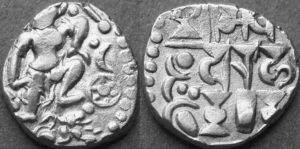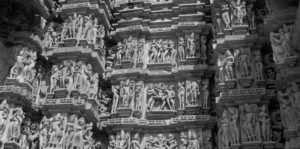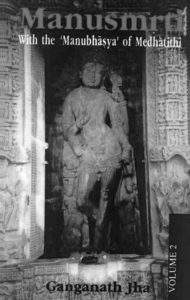Any Empire that firmly sustains for at least 220-250 years can be called a successful Empire. A protracted and vigorous rule over a geographical spread roughly equivalent to the size of four average states of today’s India was considered to be a powerful Empire. Using this yardstick, we find some royal dynasties in India such as the Mauryas, Guptas, Chalukyas, Rashtrakutas, Pratiharas and Vijayanagara. After the demise of the grand Gupta Era, several kings attempted to recreate the same grandeur. Chief among these were Yashodharma, the king of Malwa, Shashanka, the ruler of the Gauda Desha (modern Bengal), and Lalitaditya of Kashmir. However, the vast Empires of these rulers split up almost immediately after their death. Mihirakula, the son of the Hun leader Toramana, was vanquished by Yashodharma; likewise, Ishanavarma and Sharvavarma, the Maukhari kings defeated the Huns. However, none of these splendid warriors could leave behind an enduring legacy like a Skandagupta who had earlier trounced the Huns and put everlasting fear in their hearts. It is equally true that Narasimhagupta Baladitya, perhaps the last Gupta Emperor, who overwhelmed Mihirakula, hailed from Skandagupta’s lineage. But between Skandagupta and Baladitya, there was the bloodline of kings like Kumaragupta II, Puragupta, and Budhagupta. Be that as it may, the chief obstacle to the Gupta rule wasn’t the external raids of the Shakas or Huns. It was the rebellions of local vassals and chieftains like Yashodharma. Therefore, we can take consolation in the fact that the royal reigns of our country were held by our own countrymen. Through this, we can also take solace in the unbroken progress of Sanatana Dharma and its culture. Indeed, there are no two words that this is an extremely significant achievement. Akin to Yashodharma, Shashanka, Lalitaditya, the Empire that Harshavardhana Shiladitya had singlehandedly built, splintered after his death. But this was the condition of North India. However, in the South, we notice that the Pallavas, Chalukyas, Rashtrakutas and others repeatedly rekindled their glorious legacy and flourished.
Despite such glaring evidence, the history textbooks of our schools and colleges haven’t abandoned their chicanery of portraying a false picture that all of India had descended into chaos after the death of Harshavardhana. The root of this chicanery is a discourse whose contours are as follows: on the eve of Islamic invasions, all of India was divided into various factions; subsequently the Islamic regimes at Delhi reunited India, and after them, it was the Christian-fanaticism-infected British rule that generously bestowed nationalism upon our country. This illusory discourse has unfortunately been internalized even by our own so-called educated class. And this illusion has dealt a terrible blow to our native tradition of Kshatra. In reality, the Gurjara-Pratiharas, Chauhanas, Chandelas, Palas and Senas established and ran glorious Empires in the North for several centuries. Not just that. The Southern dynasties like the Chalukyas and Rashtrakutas extended their splendid runs to North India as well. Indeed, it is evident that North Indian surnames like Solanki and Rathod are derived from “Chalukya” and “Rashtrakuta.” Together with these Empires, the Kalachuris and Gangas of Kalinga also built and ran successful Empires in a big way. Given this, there was, really, no drawback to the glory of the spirit of Kshatra after Harsha’s demise. Therefore, it is pertinent to briefly examine the brilliance of the Kshatra spirit of several prominent dynasties.
The Valour of the Gurjara-Pratiharas
Like the Kadambas of Karnataka, the Gurjara-Pratiharas embraced Kshatra after migrating from Brahma into which they were originally born. The founding father of this dynasty, Harichandra was a Shrotriya Brahmana. He was the husband of a Kshatriya lady named Bhadraa. Following the death of the Malwa king Yashodharma, Harichandra took up arms as an act of Apaddharma (the Dharma of Exigency) in order to quell the chaos of anarchy that had erupted in North-Western India. He swiftly and decisively extended his sway over the entire region that includes today’s Punjab, Rajasthan, Gujarat and Sindh, and stood like the Bodyguard of India’s borders. This is how he earned the honorific of “Pratihara” (guard, protector) and became the founder of a new royal dynasty. The kings of this dynasty exerted numberless valiant efforts to halt the raids of the Arabs. They won some, lost some, and eventually disappeared owing to the vicissitudes of destiny. The Pratihara Dynasty initially flourished in the surrounding regions of today’s Jodhpur. After its peak period, this dynasty sowed the seeds for the rise of numerous Rajput dynasties. History scholars aver that the Guhilaputras of Mewad, the Chapotkatas of Patan (in today’s Rajasthan, not to be confused with Pattan in Gujarat), and Moriyas sprung up in this fashion. In reality, the Pratiharas were responsible for establishing, uniting, and organizing numerous tribes of battle-trained warriors in the Gujarat-Sindh-Rajasthan-Punjab regions. This was how an entire race of undefeatable fighting force was forged from the scratch and the spirit of Kshatra in that region was preserved for nearly a thousand years.
Another branch of the same Pratihara dynasty ruled from Avanti (or Ujjain) as its capital city. Prominent kings of this branch included Nagabhata, Vatsaraja, Nagabhata II, Bhoja, Mahendrapala, Mahipala, and others. Although Nagabhata I lost against the Rashtrakuta ruler Dantidurga, he still stood firm in the border regions. Vatsaraja (who ascended the throne in 778 CE) defeated the powerful Buddhist, Pala king of Bengal, Dharmapala and established his suzerainty over Kanyakubja for a brief spell. He had to turn back after he was defeated by the Rashtrakuta emperor, Indra. Nagabhata II emerged victorious over the Andhra-Saindhava-Vidarbha-Kalinga kings. These apart, he had subdued the Anarta (the region near Dwaraka), Malava, Kirata, Vatsa, Matsya and Turushka regions. He also wrested Kanyakubja, which had fallen back into Dharmapala’s hands, made it his capital and earned prestige by ruling from there. Unfortunately, he was defeated by Govinda of the Rashtrakutas, the long-time and powerful foes of the Pratiharas. Bhoja (not to be confused with the renowned Paramara Bhoja) who commissioned an extraordinary inscription over a long period of forty-six years, was perhaps the greatest ruler of the Pratiharas. He demolished the war-mongering Arab raiders, defeated Narayanapala in Bengal, vanquished Krishna of the Rashtrakutas, and lorded over an Empire extending from Gujarat up to Avadh (in the environs of Ayodhya). His Empire encompassed the entire region from Punjab to the Narmada and he made Kanyakubja his capital, settling there. Bhoja’s dominion was vaster than the Gupta and Harshavardhana Empires. The Arab travelers, Suleiman and Al Masoodi have profusely praised the war-readiness of Bhoja’s army, the prosperity and plenty in his Empire. They have also lamented that he is a formidable enemy of Islam. Bhoja’s son Mahendrapala was a fit successor and he further expanded the Empire he inherited from his father. He granted patronage to the famous poet and Pandit, the talented Rajashekhara. His reign witnessed a tremendous opulence in the realms of art, literature, sculpture, architecture, dance, music, Sanatana Shastra and tradition, and trade and commerce. The contribution that Gurajara-Pratiharas made to Sanatana Dharma is truly bounteous. They built innumerable temples in a grand style by endowing them with generous grants. As a counter to the numerous temples that Islam had destroyed, they designed and built scores of temples, agraharams, and centers of learning. The Kanyakubja that they improved and beautified, thrived as the Centre of Indian Culture for more than two hundred years unrivalled. Its fateful destruction occurred at the demonic hands of Ghazni Mahmud. Mahendrapala’s son Mahipala followed in the footsteps of his illustrious father and flourished likewise. Although his Empire extended from Dwaraka in the West to Varanasi in the East, he eventually passed away, unable to withstand the force of the relentless attacks from the Rashtrakutas. Repeated attacks from Rashtrakuta kings like Krishna II, Indra III and Krishna III, and rebellions from vassals like the Chandelas, Kalachuris, and Paramaras eventually sidelined the Pratiharas. In the end, the glory of this great dynasty is forever unparalleled, praiseworthy, and memorable. During the reign of the Pratiharas, there was a continuation of the glory that Sanatana Dharma enjoyed during the Gupta Era. It scaled amazing peaks in the realms of Purana, Agama, Dharmashastra, literature, and art. This great dynasty acted as the foundation for and invested enormous effort to stem the tide of Islam’s raids and to safeguard, preserve, and disseminate Sanatana Dharma. Towards this end, it devoted its military strength, organization, and arsenal, and achieved all-round prosperity in industry, agriculture, and commerce.
It is for this reason that we discern an echo of all these aspects in the first-ever commentary on the Manusmriti written by Medhatithi who lived in the Pratihara period. He provided a space-neutral commentary to regions such as the Aryavarta, Brahmavarta, and regions where Yajna was performed. This in turn helped the growth and development of what’s known as the Brihad-Bharata (loosely, Greater India) from the perspective of a unity of cultural feeling. More importantly, the manner in which Medhatithi has expounded on the innate dynamism and magnanimity of the Varnashrama system, the provision of re-welcoming into Sanatana Dharma those Hindus who were forcibly converted, the method of restoring dignity to women who were raped by the Mlecchas, and his firm opposition to the practice of Sati—all of these are unequivocally praiseworthy and eminently notable. This apart, Medhatithi’s endorsement of and emphasis on Kshatra and his contemplations on the shrewdness, generosity, steely grit, and wisdom in subduing the enemy are valuable for all time. In reality, Medhatithi is a harmonious blend of idealism and pragmatism. More importantly, if Medhatithi’s thoughts had been developed and adhered to in our efforts at countering Islamic invasions, the fate of our country would’ve been vastly different. From this we also discern the role and importance of the Pratiharas who shaped him. As also the towering stature of its preeminent king Mihirabhoja or Vruddhabhoja. To be continued Translated by Hari Ravikumar and Sandeep Balakrishna




















































